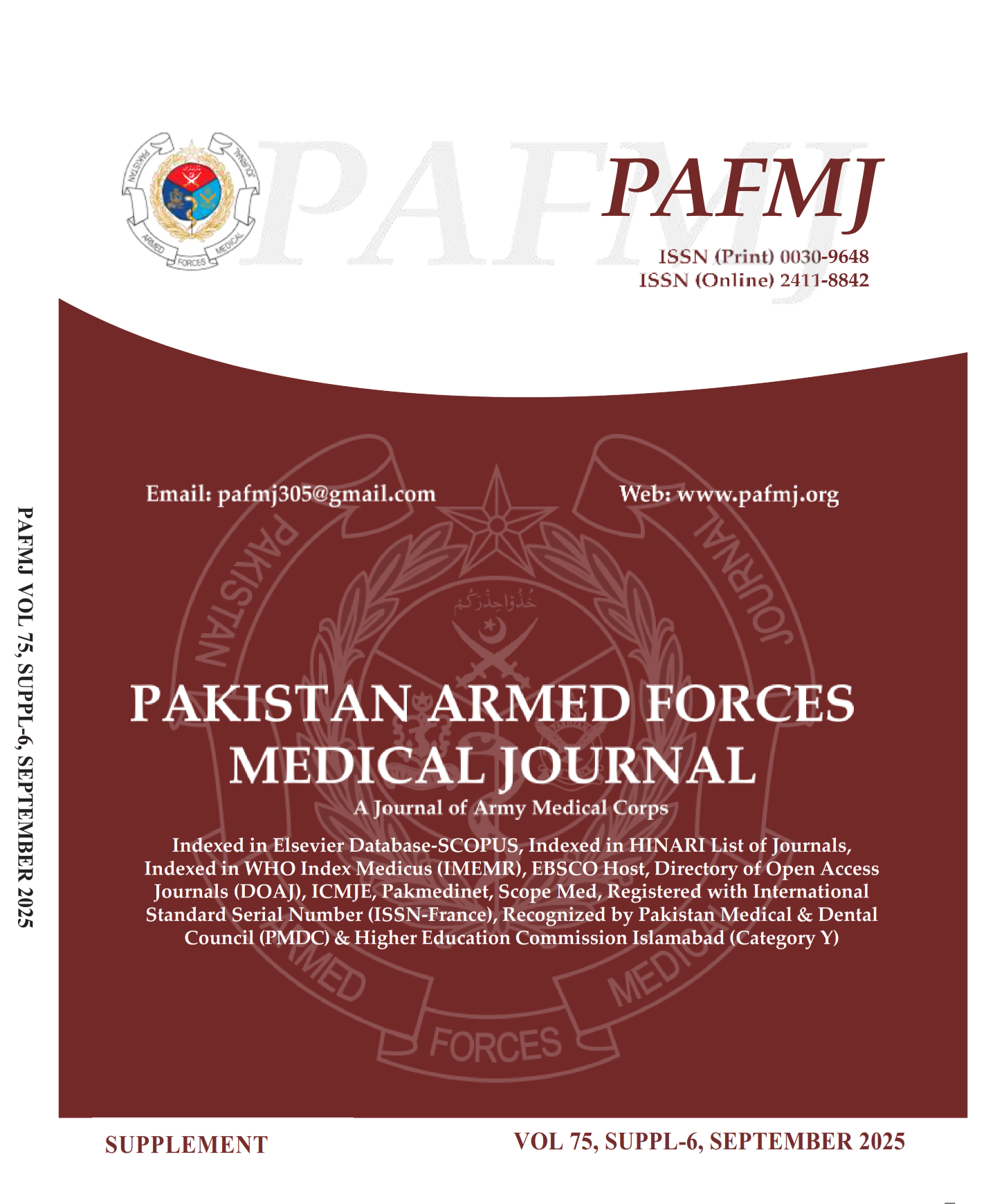Renal Tubular Injury in Albino Rats after using Heavy Metal Copper Dosage: A Histopathological Study
DOI:
https://doi.org/10.51253/pafmj.v75iSUPPL-6.8052Keywords:
Copper, Diet, Dilatation, Epithelial Cell, Inflammation, Necrosis, Rats, Renal Tubules.Abstract
Objective: To compare the impact of doses of heavy metals like copper on renal tubules in albino rats.
Study Design: Comparative Cross-sectional study.
Place and Duration of Study: Pathology Department of Services Institute of Medical Science, (Animal House) University of Health Sciences, Lahore Pakistan, from Nov 2018 to May 2019.
Methodology: Two groups of Wistar Albino rodents were categorized as control and study groups consisting of ten rodents. Only standard pellets diet of mice with tap water was given to all control group members. On the contrary, the heavy metal dose was calculated according to the bodyweight of the rodents in the study group. The dose was given to the rodents every alternate day for up to eighteen weeks. At the end of the experiment, changes in renal tubules were compared microscopically and statistically analyzed in both categories, keeping the p-value of <0.05 as significant.
Results: The results showed that morphological changes in renal tubules in tubular epithelial necrosis and dilatation were significantly different in all members of both categories’., epithelial necrosis; (n=10, 100%, p<0.001), followed by dilatation (n=10, 100%, p<0.001), casts (n=10, 100%, p<0.001), basement membrane thickening (n=10, 100%, p<0.001), and vacuolization (n=10, 100%, p<0.001).
Conclusion: This study found that heavy metals like copper can cause renal tubular necrosis, dilatation, and inflammation.
Downloads
References
Xu X, Nie S, Ding H, Hou FF. Environmental pollution and kidney diseases. Nat Rev Nephrol 2018; 14(5): 313-324.
2. Sall ML, Diaw AKD, Gningue-Sall D, Efremova Aaron S, Aaron JJ. Toxic heavy metals: impact on the environment and human health, and treatment with conducting organic polymers, a review. Environ Sci Pollut Res Int 2020; 27(24): 29927-42.
3. Taylor AA, Tsuji JS, Garry MR, McArdle ME, Goodfellow WL, Adams WJ, et al. Critical Review of Exposure and Effects: Implications for Setting Regulatory Health Criteria for Ingested Copper. Environ Manage 2020; 65(1): 131-159.
4. Padrilah SN, Sabullah MK, Shukor M, Yasid NA, Shamaan NA, Ahmad SA. Toxicity effects of fish histopathology on copper accumulation. Pertanika J Trop Agric Sci 2018; 41(2): 519-540.
5. Bind A, Goswami L, Prakash V. Comparative analysis of floating and submerged macrophytes for heavy metal (copper, chromium, arsenic and lead) removal: sorbent preparation, characterization, regeneration and cost estimation. Geology, Ecology, and Landscapes 2018; 2(2): 61-72.
6. Abhijit G, Jyoti J, Aditya S, Ridhi S, Candy S, Gaganjot K. Microbes as potential tool for remediation of heavy metals: a review. J Microb Biochem Technol 2016; 8(4): 364-372.
7. Rana MN, Tangpong J, Rahman MM. Toxicodynamics of Lead, Cadmium, Mercury and Arsenic- induced kidney toxicity and treatment strategy: A mini review. Toxicol Rep 2018; 5: 704-713.
8. Kurisaki E, Kuroda Y, Sato M. Copper-binding protein in acute copper poisoning. Forensic Sci Int 1988; 38(1-2): 3-11.
9. Akintunde JK, Oboh G. Nephritic cell damage and antioxidant status in rats exposed to leachate from battery recycling industry. Interdiscip Toxicol 2016; 9(1): 1-11.
10. Pregel P, Scala E, Bullone M, Martano M, Nozza L, Garberoglio S, et al. Radiofrequency Thermoablation On Ex Vivo Animal Tissues: Changes on Isolated Swine Thyroids. Front Endocrinol (Lausanne) 2021; 12: 575565.
11. Garcês A, Pires I. Necropsy Techniques for Examining Wildlife Samples: Bentham Science Publishers; 2020.
12. Bugata LSP, Pitta Venkata P, Gundu AR, Mohammed Fazlur R, Reddy UA, Kumar JM, et al. Acute and subacute oral toxicity of copper oxide nanoparticles in female albino Wistar rats. J Appl Toxicol 2019; 39(5): 702-716.
13. Anant JK, Inchulkar S, Bhagat S. An overview of copper toxicity relevance to public health. EJPMR 2018; 5(11): 232-237.
14. Hashimyousif E, Obaid HM, Karim AJ, Hashim MS, Naimi RAA. Toxico pathological study of copper sulfate modulate by zinc oxide and Coriandrum sativum plant treatment in mice. Plant Archives 2019; 19(1): 299-308.
15. Baruah S, Goswami S, Kalita D. Haematobiochemical and pathological alterations of chronic copper toxicity in ducks. J Anim Res 2018; 8(2): 283-287.
16. Goma A, Tohamy H. Impact of some heavy metals toxicity on behaviour, biochemical and histopathological alterations in adult rats. Adv Anim Vet Sci 2016; 4(9): 494-505.
17. Shahsavari A, Tabatabaei Yazdi F, Moosavi Z, Heidari A, Sardari P. A study on the concentration of heavy metals and histopathological changes in Persian jirds (Mammals; Rodentia), affected by mining activities in an iron ore mine in Iran. Environ Sci Pollut Res Int 2019; 26(12): 12590-604.
18. Babaknejad N, Moshtaghie AA, Shahanipour K. The toxicity of copper on serum parameters related to renal functions in male wistar rats. Zahedan J Res Med Sci 2015; 15: 29-31.
Downloads
Published
Issue
Section
License
Copyright (c) 2025 Hira Kareem, Amna Jahan, Sobia Jahangir, Roop e Zahra, Arslan Haider, Romman ul Haq

This work is licensed under a Creative Commons Attribution-NonCommercial 4.0 International License.















